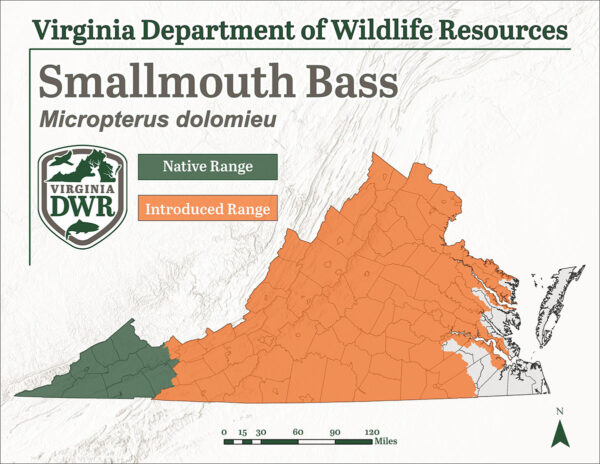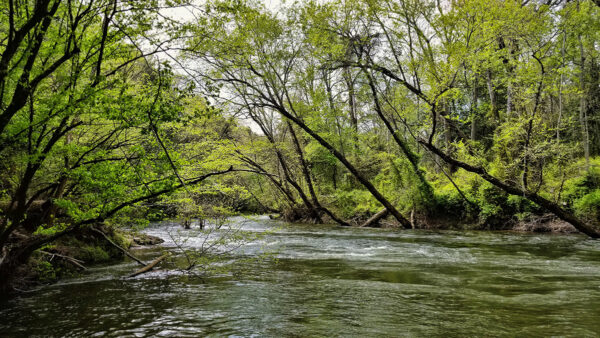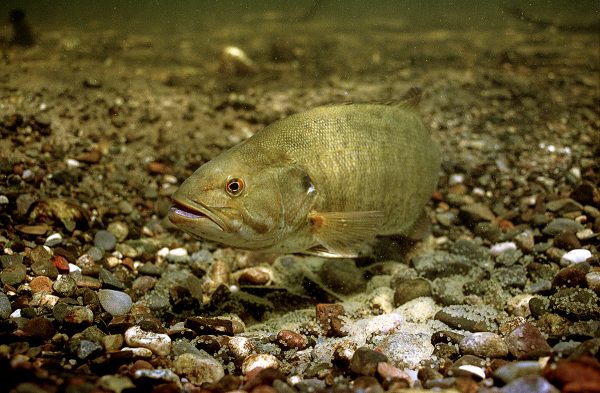A Smallmouth Bass being released back to its waters.
A Smallmouth Bass being measured during a sampling event. ©Photo by Hunter Hatcher
Fact File
Scientific Name: Micropterus dolomieu
Classification: Fish, Order Perciformes, Family Centrarchidae
Size: Smallmouth Bass in Virginia can exceed 20 inches in length and 5 pounds in weight
Life Span: About 15 years
Identifying Characteristics

Fisheries Biologist Tyler Young displays a Smallmouth Bass captured during a fall community fish survey.
- Elongate, laterally compressed body shape
- Dark bars radiate from the eye on the cheek and gill cover
- Dorsal fin is not as deeply notched as the Largemouth Bass
- When the mouth is closed, the jaw bone does not extend beyond the eye
- Body color varies greatly based on diet, habitat, and watershed – but is most often brown or bronze
Diet
Smallmouth Bass are often one of the top predators in the environments they inhabit, and will prey opportunistically on anything they can catch. Smallmouth Bass consume a large diet of benthic macroinvertebrates as juveniles, but eventually begin to prefer preying on crayfish and other fish.
Distribution:
In Virginia, Smallmouth Bass are native to the upper portions of the Big Sandy, Clinch, Holston, Powell, and Tug watersheds in the southwest portion of the state. Introductions of Smallmouth Bass have lead to established populations throughout coolwater portions of most of Virginia.

Habitat
Smallmouth Bass thrive in oxygenated coolwater streams with gravel bottoms. They take advantage of different stream features such as riffles, runs, or deep pools depending on the time of year and their metabolic needs at that time. Like other ambush predators, Smallmouth Bass take cover in areas with riparian cover, or under fallen trees, rock ledges, and grass beds. Smallmouth Bass can also be found within several of Virginia’s reservoirs where there is pristine water quality and ample submerged structure. Smallmouth Bass are intolerant of siltation, elevated stream temperatures, and pollutants.

A medium-sized river where Smallmouth Bass can be found.
Reproduction
Smallmouth Bass spawn in the spring as water temperatures begin to surpass 60°F. The males construct nests on gravelly substrates in about 2 to 4 ft. of water. Males exhibit territorial parental behavior, defending both the nesting site and freshly hatched young.

A Smallmouth Bass defends his territory.
Additional Information
Last updated: April 9, 2024
The Virginia Department of Wildlife Resources Species Profile Database serves as a repository of information for Virginia’s fish and wildlife species. The database is managed and curated by the Wildlife Information and Environmental Services (WIES) program. Species profile data, distribution information, and photography is generated by the Virginia Department of Wildlife Resources, State and Federal agencies, Collection Permittees, and other trusted partners. This product is not suitable for legal, engineering, or surveying use. The Virginia Department of Wildlife Resources does not accept responsibility for any missing data, inaccuracies, or other errors which may exist. In accordance with the terms of service for this product, you agree to this disclaimer.

